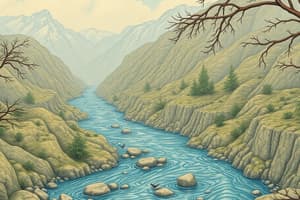Podcast
Questions and Answers
What does the term 'drainage' describe?
What does the term 'drainage' describe?
The river system of an area.
Which of the following are the two major groups of Indian rivers?
Which of the following are the two major groups of Indian rivers?
- Desert rivers
- Floodplain rivers
- Peninsular rivers (correct)
- Himalayan rivers (correct)
Most Himalayan rivers are perennial.
Most Himalayan rivers are perennial.
True (A)
What is a drainage basin?
What is a drainage basin?
What is a water divide?
What is a water divide?
Which river has the largest basin in India?
Which river has the largest basin in India?
Which river originates from the north of the mountain ranges?
Which river originates from the north of the mountain ranges?
Name the three major Himalayan rivers.
Name the three major Himalayan rivers.
What drainage pattern resembles the branches of a tree?
What drainage pattern resembles the branches of a tree?
What is a trellis drainage pattern?
What is a trellis drainage pattern?
Where do most rivers of Peninsular India originate?
Where do most rivers of Peninsular India originate?
Flashcards are hidden until you start studying
Study Notes
Drainage
- Drainage refers to the river system of an area.
- Streams flowing from different directions come together to form a main river.
- The area drained by a single river system is called a drainage basin.
- An elevated area, like a mountain or upland, separates two drainage basins and is known as a water divide.
- The world's largest drainage basin is the Amazon River's basin.
- India's drainage systems are primarily controlled by the country's relief features.
- The Indian rivers are categorized into two main groups: Himalayan rivers and peninsular rivers.
Himalayan Rivers
- Most Himalayan rivers are perennial, meaning they have water throughout the year.
- They receive water from rainfall and melted snow from the Himalayas.
- The Indus and Brahmaputra Rivers originate in the north of the mountain ranges.
- These rivers have cut through the mountains, creating gorges.
- Himalayan rivers have long courses from their source to the sea.
- They exhibit significant erosional activity in their upper courses, carrying large amounts of silt and sand.
- In the middle and lower courses, they form meanders, oxbow lakes, and other depositional features on their floodplains.
- Himalayan rivers have well-developed deltas.
Peninsular Rivers
- Peninsular rivers have generally shallower courses than their Himalayan counterparts.
- Some originate in the central highlands and flow towards the west.
- Most peninsular rivers originate in the Western Ghats and flow towards the Bay of Bengal.
Drainage Patterns
- Drainage patterns within a basin are influenced by the land slope, underlying rock structure, and climate.
- The dendritic pattern occurs when the river channel follows the terrain's slope and resembles a tree's branches.
- A trellis pattern develops where hard and soft rocks exist parallel to each other, with tributaries joining the river at right angles.
- A rectangular drainage pattern forms in strongly jointed rocky terrains.
- The radial pattern occurs when streams flow outward from a central peak or dome-like structure.
- A drainage basin may exhibit a combination of different patterns.
Studying That Suits You
Use AI to generate personalized quizzes and flashcards to suit your learning preferences.




